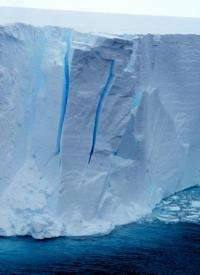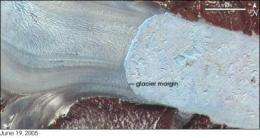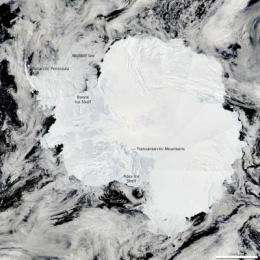Warming ocean layers will undermine polar ice sheets

Warming of the ocean's subsurface layers will melt underwater portions of the Greenland and Antarctic ice sheets faster than previously thought, according to new University of Arizona-led research. Such melting would increase the sea level more than already projected.
The research, based on 19 state-of-the-art climate models, proposes a new mechanism by which global warming will accelerate the melting of the great ice sheets during this century and the next.
The subsurface ocean layers surrounding the polar ice sheets will warm substantially as global warming progresses, the scientists found. In addition to being exposed to warming air, underwater portions of the polar ice sheets and glaciers will be bathed in warming seawater.
The subsurface ocean along the Greenland coast could increase as much as 3.6 F (2 C) by 2100.
"To my knowledge, this study is the first to quantify and compare future ocean warming around the Greenland and the Antarctic ice sheets using an ensemble of models," said lead author Jianjun Yin, a UA assistant professor of geosciences.
Most previous research has focused on how increases in atmospheric temperatures would affect the ice sheets, he said.
"Ocean warming is very important compared to atmospheric warming because water has a much larger heat capacity than air," Yin said. "If you put an ice cube in a warm room, it will melt in several hours. But if you put an ice cube in a cup of warm water, it will disappear in just minutes."
Given a mid-level increase in greenhouse gases, the researchers found the ocean layer about 650 to 1,650 feet (200 to 500 meters) below the surface would warm, on average, about 1.8 F (1 C) by 2100.

Along the Greenland coast, that layer would warm twice as much, but along Antarctica would warm less, only 0.9 F (0.5 C).
"No one has noticed this discrepancy before – that the subsurface oceans surrounding Greenland and Antarctica warm very differently," Yin said.
Part of the warming in the North comes from the Gulf Stream carrying warm subtropical waters north. By contrast, the Antarctic Circumpolar Current blocks some of the subtropical warmth from entering the Antarctic's coastal waters.
Even so, the Antarctic ice sheet will be bathed in warming waters, the team writes.
Co-author Jonathan T. Overpeck said, "This does mean that both Greenland and Antarctica are probably going melt faster than the scientific community previously thought."
Overpeck, a UA professor of geosciences and co-director of UA's Institute of the Environment, said, "This paper adds to the evidence that we could have sea level rise by the end of this century of around 1 meter and a good deal more in succeeding centuries."
The paper by Yin, Overpeck and their colleagues, "Different Magnitudes of Projected Subsurface Ocean Warming Around Greenland and Antarctica," is scheduled for online publication in Nature Geoscience on July 3.
Their co-authors are UA assistant professor of geosciences Joellen L. Russell; Stephen M. Griffies and Ronald J. Stouffer of the National Oceanographic Atmospheric Administration's Geophysical Fluid Dynamics Laboratory in Princeton, N.J.; and Aixue Hu of the National Center for Atmospheric Research in Boulder, Colo.
Other researchers have recently measured surprisingly high subsurface ocean temperatures along coastal glaciers in Greenland, Yin said. In addition, scientists have reported the Greenland and Antarctica glaciers that empty into the sea are moving faster.
Yin decided to figure out how much those subsurface currents would warm during this century and the next.

Glaciers are rivers of ice. Like rivers of liquid water, glaciers move downhill. Some glaciers melt before reaching the ocean, and others, called tidewater glaciers, flow all the way to the sea.
The face of a tidewater glacier visible from a boat is only part of it – much of the glacier's leading edge is underwater in a deep fjord.
Yin's research suggests Greenland's glaciers are being exposed to increasingly warm subsurface water that will melt the underwater portion of the glaciers. As a result, the tops of the glaciers will no longer have support and will topple into the sea, creating icebergs. In addition, as the undersides of the glaciers melt, that meltwater will speed the glaciers' movement into the sea by lubricating their undersides.
Ultimately, those glaciers will melt back so far they no longer reach the sea, the team writes.
In contrast, much more of the Antarctic ice sheet is based on land that is already below sea level. Therefore as the Antarctic ice sheet melts back, the leading edge of the ice sheet will continue to be underwater. As such warming and melting continues into the 22nd century and beyond, parts of the Antarctic ice sheet may disintegrate, the team writes.
Yin's next step is examining climate models that can zero in even further on the regional effects of climate warming on the subsurface ocean and the ice sheets.
Provided by University of Arizona
















